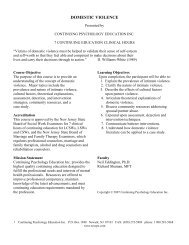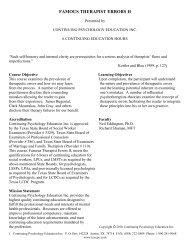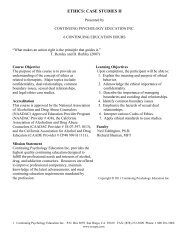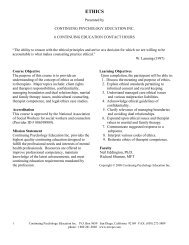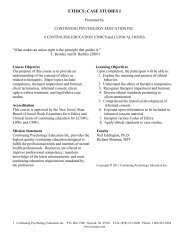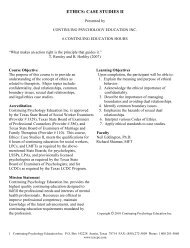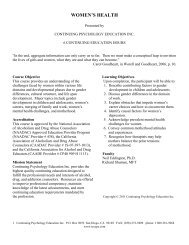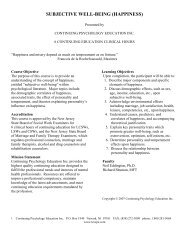FAMOUS THERAPIST ERRORS - Continuing Psychology Education
FAMOUS THERAPIST ERRORS - Continuing Psychology Education
FAMOUS THERAPIST ERRORS - Continuing Psychology Education
You also want an ePaper? Increase the reach of your titles
YUMPU automatically turns print PDFs into web optimized ePapers that Google loves.
<strong>FAMOUS</strong> <strong>THERAPIST</strong> <strong>ERRORS</strong>want to do that, I don’t like this stuff. I like the way it wasbefore when I didn’t feel anything.”Therapist told client that releasing feelings hurts at first butlater if feels better and that his physical problems werecaused by keeping his feelings inside. Nonetheless, clientdiscontinued therapy which left therapist with anuncomfortable feeling. Oaklander assessed the case andconcluded that she hurried the pace of therapy, “I had gonemuch too fast with him and I just hadn’t paced the sessions. Ihad just pushed him – it didn’t feel like I pushed him – butthat’s really what I did. I just kept going further and furtherand pushing him and all these things would come out. It waslike he lost control over himself and I certainly didn’t helphim feel any control over anything. I thought a lot about this.I learned a lot about pacing sessions and being careful,particularly with a child with his background.” Therapistresolved that children cannot manage a lot of expression offeelings all at one time as adults can due to a lack of egostrength. She stated, “Often children will take care ofthemselves by breaking contact. They say they don’t want todo it anymore. With a child with his background, I needed tobe more alert about not pushing him too hard. Ever since thatcase, I have handled this differently.”Another unsettling concern for Oaklander is that she neverlearned what happened to client which left her with a feelingof uncertainty as expressed by, “I try to comfort myself thatwhatever we did together might have been helpful to him, butI am really not sure about that.”In a second case, Oaklander described a 13 year-old boywho was often truant from school and was failingacademically. His mother brought him in and she was angrywith his behavior.Therapist observed that client was not emotionallyexpressive and would not be motivated for projective workbut he did show enthusiasm toward fishing which was hisfavorite activity during his school truancy time. Therapistadvised the mother to notify the school of her intention toallow her son periodic mental health days to go fishing whichmight heighten desire to attend school. Therapist alsorecommended to mother to seek professional help for somelearning disabilities that she observed in client and suchimprovement could make a big difference. The mother saidshe could not possibly do that then she got angry withtherapist and immediately terminated her son’s therapy.Sadly, the mother called therapist about a month later andsaid that her son had hanged himself and she wished she hadlistened to therapist. Oaklander recounted, “Since then, I’vealways wondered about what I could have done or said sothat she would have listened to me. I don’t know if it wouldhave helped him or not, but I always wondered about what Ihad missed.”Upon reflection, Oaklander realized that she may havegiven ample attention to client but not enough to mother. “Iknow sometimes I will be so much the child’s advocate that Imight forget to listen to the parent, to honor the parent.” Inhindsight, therapist would have been more empathetic withmother’s feelings and frustration, in her words, “It is nothelpful to the child if we antagonize the parents, or if wecriticize them. Some parents are not ready to hear things thatwe tell them. And I think where I went wrong is that hismother felt criticized by me.”Each of Oaklander’s cases illustrates that failure may occurdespite good rapport with child or adolescent if parent isignored or not valued; contrarily, she admits, “Parents taketheir kids out of therapy when it’s not time, or it’s too soon”resulting in a sense of futility over lack of control of parentalaction.RICHARD SCHWARTZDr. Schwartz pioneered the Internal Family Systems modelof psychotherapy which combines family therapy with intrapsychicfactors. Clients learn to separate their extremebeliefs and emotions thus liberating a wise andcompassionate Self-state capable of creating harmony withself and others. His accomplishments include being associateprofessor at the University of Illinois at Chicago andNorthwestern University and Fellow of the AmericanAssociation for Marriage and Family Therapy. He authoredthe book, Internal Family Systems Therapy and co-authoredFamily Therapy: Concepts and Methods, a widely-readfamily therapy textbook; additionally, he has been on theeditorial board of four professional journals and he developedthe Center for Self Leadership in Oak Park, Illinois, designedto address issues of violence, racism, abuse and oppression.Schwartz notes that some therapists pathologize theirclients by using the DSM (Diagnostic and Statistical Manual)as a Bible, hence, only perceiving the individuals throughthat scope of vision. This view can lead to therapy becomingmere self-fulfilling expectations and the therapist’s selfprotectivenesscan trigger unhealthy aspects within client.Schwartz pleasantly admits, “I don’t have these strugglesbecause I don’t make those presumptions about people whenthey come in.” His therapeutic method avoids traditionaldiagnostic labels and focuses instead on labeling importantparts of the self. People, including therapists, have manydifferent parts along with a “core” self; the concern is thatone part, for example, having extreme reactions to people,may take charge of the therapy session and lead to nonproductivity.This therapist discloses, “My goal when I amworking is to try to maintain what I call “self-leadership”most of the time. I have my parts around, but I won’t havethem taking over… It’s a different take oncountertransference. The parts of me that have gotten me introuble would include parts that can be very impatient andthink that therapy is taking too long.” The “impatient self,”Schwartz admitted, may encourage him to rush clients intodoing things before they are ready and the part within himdesiring to be entertained can attempt to rush the pace oftherapy to the detriment of the client.A dislike of clients who are highly dependent, yetdemanding is another part of self that Schwartz must be7 <strong>Continuing</strong> <strong>Psychology</strong> <strong>Education</strong> Inc.



